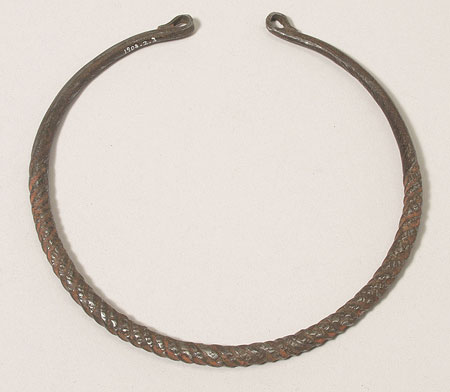Accession Number:
1903.2.3
Country:
Sudan
Region:
[Southern Sudan] Bahr el Jebel Gondokoro
Cultural Group:
Bari
Date Made:
By 1903
Materials:
Iron Metal
Process:
Hammered , Twisted , Incised
Dimensions:
Max W = 130.7 mm Max L = 134.2 mm Max Diam = 6 mm Max W [at looped end] = 3.7 mm Max Th [at looped end] = 1 mm
Weight:
72.0 g
Other Owners:
William Leonard Stevenson Loat
Field Collector:
?William Leonard Stevenson Loat
PRM Source:
William Leonard Stevenson Loat
Acquired:
Donated February 1903
Collected Date:
By 1903
Description:
Iron torque made from a rod with round section, tapering to either end.
This has been twisted, so that two thirds of the body is covered with a spiralling groove that flattens out towards the ends, which have been hammered flat and have rectangular sections.
These ends have been bent over and hammered back against the body to form two loops.
This rod has been bent into a circular loop with open ends, 26 mm apart.
It has been further decorated by chiselling a series of short oblique lines across the raised sections of the twisted body on the upper side.
The object is complete and intact, and is currently a metallic dark gray colour (Pantone 422C), with traces of red ochre in many of the twisted grooves and adhering to the end loops (Pantone 174C).
It measures 130.8 across the outside diameter, 134.2 mm across the length, while the rod from which it is made has a maximum diameter of 6 mm, and at its looped ends, a width of 3.7 mm and a thickness of 1 mm.
It weighs 72 grams.
Collected by William Leonard Stevenson Loat at Gondokoro in March 1902; Loat is known to have worked around Gondokoro during 1902 (see Boulenger, G.A., 1902, “List of the fishes collected by Mr. W.L.S. Loat at Gondokoro”, Ann. Mag. Nat. Hist. (Ser. 7) 10 (38), pp 260-264) . At the time this object was collected, the Ugandan border lay just north of Gondokoro (it was moved further south in 1910). It was donated to the Museum in February 1903.
This object was originally identified as a bracelet, but its diameter suggests a more likely use as a neck ornament. Petherick describes what sounds like a similar necklace being worn by Chief Bubauglae of the Bari in 1863, somewhere in the region of the town of Manio: "his necklace was of finely-twisted iron; and on his arms he wore brightly polished bands made of the same metal" (J. & Petherick 1869, Travels in Central Africa and Explorations of the Western Nile Tributaries, p. 307). This object can be compared with 1934.8.52, from Mongalla, which has a more complex design with projecting ends. Similar red ochre traces were found on 2 other Bari objects in the collection; armlets 1934.8.50-51, and on a Lotuko twisted torque, 1934.8.67 and hide necklets 1934.8.70-71. It is also similar to the 'red paste' in which a number of beads are embedded on Murle bracelet 1884.82.23.
Rachael Sparks 30/9/2005.
Collected by William Leonard Stevenson Loat at Gondokoro in March 1902; Loat is known to have worked around Gondokoro during 1902 (see Boulenger, G.A., 1902, “List of the fishes collected by Mr. W.L.S. Loat at Gondokoro”, Ann. Mag. Nat. Hist. (Ser. 7) 10 (38), pp 260-264) . At the time this object was collected, the Ugandan border lay just north of Gondokoro (it was moved further south in 1910). It was donated to the Museum in February 1903.
This object was originally identified as a bracelet, but its diameter suggests a more likely use as a neck ornament. Petherick describes what sounds like a similar necklace being worn by Chief Bubauglae of the Bari in 1863, somewhere in the region of the town of Manio: "his necklace was of finely-twisted iron; and on his arms he wore brightly polished bands made of the same metal" (J. & Petherick 1869, Travels in Central Africa and Explorations of the Western Nile Tributaries, p. 307). This object can be compared with 1934.8.52, from Mongalla, which has a more complex design with projecting ends. Similar red ochre traces were found on 2 other Bari objects in the collection; armlets 1934.8.50-51, and on a Lotuko twisted torque, 1934.8.67 and hide necklets 1934.8.70-71. It is also similar to the 'red paste' in which a number of beads are embedded on Murle bracelet 1884.82.23.
Rachael Sparks 30/9/2005.
Primary Documentation:
Accession Book Entry
[III, p.
103] - 1903 [pencil insert] 2 [end insert]
W.L.S.
LOAT
Esq.
Cumnor,
Berks
.
Feb.
[pencil insert] 3 [end insert] - Bari iron torque bracelet, ib[idem] [Gondokoro, Uganda Prov.].
Card Catalogue Entry - There is no further information on the tribes catalogue card [RTS 12/2/2004].
Pitt Rivers Museum label - BARI necklet, GONDOKORO, UGANDA. March, 1902. Pres. by W.L.S. Loat Esq. 1903. [rev] 1903.2.3 [N.B. 'DCF 2004-2006 What's Upstairs?' 24/6/2005]
Card Catalogue Entry - There is no further information on the tribes catalogue card [RTS 12/2/2004].
Pitt Rivers Museum label - BARI necklet, GONDOKORO, UGANDA. March, 1902. Pres. by W.L.S. Loat Esq. 1903. [rev] 1903.2.3 [N.B. 'DCF 2004-2006 What's Upstairs?' 24/6/2005]



